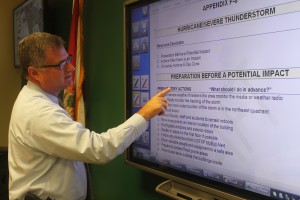
The main emergency operation center for the university was completed this fall. The center, located within the campus police department on Third Street S., tracks virtually anything that occurs on campus, from a hurricane to a special event to a campus crisis.
The large interactive room has multiple components: a constant weather feed, a camera monitoring system connecting more than 300 cameras located throughout the campus, and a basic cable feed that airs channels such as CNN, the Weather Channel or any other local news stations.
The work for the center began this past spring, and equipment began to arrive over the summer after the funding was complete. The project, which cost about $15,000, was fully funded by the university as part of the needs for public safety.
“The university is in a constant process of updating equipment, but we didn’t have to do anything special for this project,” said David Hendry, director of police services. “In fact everything here is over-the-counter type products, so it makes it easier to use.”
There is also a large touch screen in the center of the room that is connected to the internet. This screen allows for maps and checklists to be pulled up and directly drawn on. A printer is connected to the system so anything that is used can be distributed.
Hendry said getting this center set up and running was his number one priority when he joined the campus a year ago. Hendry has over 30 years of experience in law enforcement and says that the center is the “best practice for any university.” Having this technology available is crucial for keeping the campus safe.
“Bringing all of this technology together reflects the university’s commitment to public safety and the safety of the campus,” Hendry told The Crow’s Nest.
Hendry said that the one of the most important capabilities within the center is the ability for everyone to speak together if needed, which can be done through the conference call telephone or a video chat.
When the science festival took place on campus last month, more than 15,000 people occupied the campus. The emergency center was set up as a dispatch center to make sure the event ran smoothly.
The space will also be used to train faculty and staff to make sure everyone is prepared for any type of emergency.
Before this center was made, emergency plans were available and there were telephone and network capabilities. However now those capabilities are much more efficient.
“A lot of the parts and pieces were in place but we hadn’t really drawn in a lot of the technology yet.” Hendry said. “We were able to take advantage of what the university does to keep the campus safe and bring it all into one space.”


